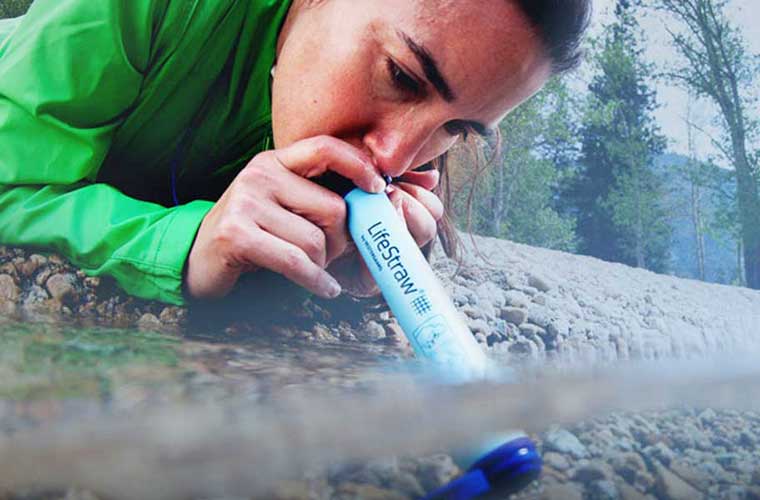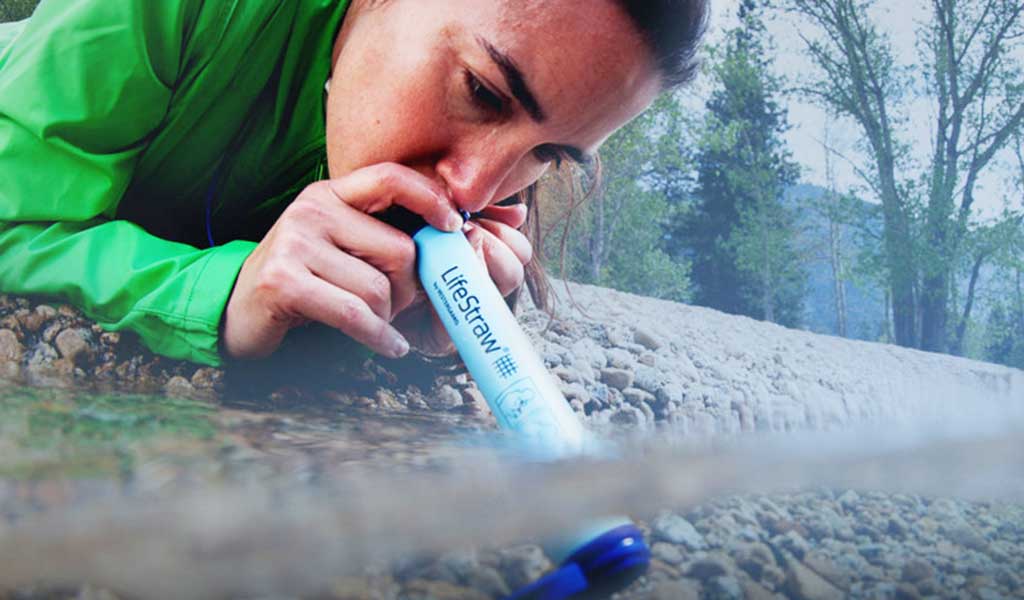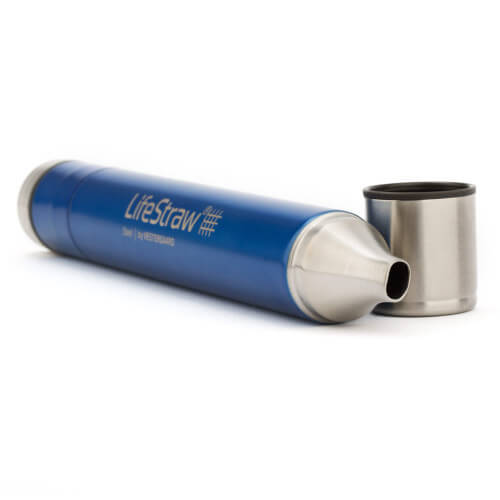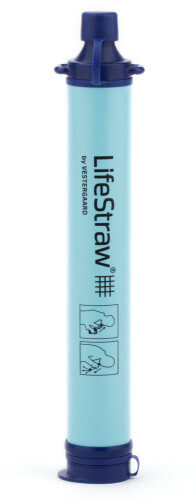Portable personal water filters for outdoor and trekking equipment

Any activity that is outdoors is closely linked to having an adequate water supply, since in order to function at 100 % of our capabilities, good hydration is necessary.. Even if we are aware of the sources we may encounter on our routes, no one can be sure that it is safe to drink. whatever is in them. It is very important to know that drinking contaminated water could cause vomiting, nausea, fever or diarrhoea, which, in addition to being a threat to our health, could also ruin our outing. Hence the importance of a portable water purification filter and know how to use water in a healthy and safe way.
READ ALSO: 101 gadgets for outdoor and mountain use"
How can we distinguish drinking water?
In order for water to be considered safe and potable, water does not necessarily have to be free of pathogens.. The amount of these elements in such water, including particulate matter that may cloud it, should not constitute a risk to human health. The concentrations of pesticides, minerals, antibiotics, fertilisers and other pollutants that may be found in water, in general, would not affect health if it is used only sporadically.
Difference between water filters and water purifiers
The difference between the two lies in the size of the micro-organism that each fights:
The personal water filter act by eliminating protozoan cysts, such as the Giardia lamblia and the cryptosporidiumand also bacteria such as Salmonella, Shigella, Campylobacter or the E. coli.
Water purifiers also combat viruses that are too small for most water filters.
Methods to get rid of possible bacteria and other contaminants?
What we are most concerned about in water are biological pathogens, which are basically viruses, bacteria and protozoa. We can divide the way to get rid of them into two methods: 'safe' or 'standard', which are like the boiling method, using the 'safe' or 'standard' method, which are like the boiling method, using the 'safe' or 'standard' method. special filters or use chemicals. On the other hand, we have the so-called 'emergency' or 'improvised' methods, the former being methods that simply seek to minimise the pathogen load, although not to 100 %, and the latter those that give us safe drinking water.
Boiling water method
With the method of by bringing the water to the boiling point, all pathogens are eliminated, except for the hepatitis A virus.. So, we recommend that anyone travelling to a place where the disease is present should get vaccinated before going. To apply this method to water, it is as simple as boiling for one to three minutes, if you are at a higher altitude. A negative point is that we will need large amounts of fuel to be able to perform this method with all the water we want to drink.
Chemical disinfection method
This method is carried out using products that contain calcium hypochlorite or sodium hypochlorite. It is not recommended to use iodine or products containing iodine. Silver ions do not achieve complete disinfection because they are not broad-spectrum bactericides, i.e. they do not kill all bacteria, but they do serve to keep water clean for up to 6 months. The following could be used chlorine household (unscented) in a proportion of 10 drops per litre of water, mix and leave to stand for 30 minutes before drinking.. If the water was cloudy, 20 drops would be used. Due to the instability of chlorine, the chlorination effect would only last 1 or 2 days. A disadvantage is that at low temperatures (2 to 5 degrees) the time needed for the chlorine to disinfect quadruples.
FiltersWhat do they consist of?
The filtering method is simple, consisting of The water passes through membranes which, thanks to the pores, which, due to their hydrophobic properties or electrostatic charge, retain the germs in their pores, and which, due to their hydrophobic properties or electrostatic charge, retain the germs in their pores.s. It is a very simple method, but must be complemented by chemical disinfection, as filters do not remove viruses. Filters for outdoor activities are available on the market with different characteristics, from hand pumps with ceramic filters to bulbs with built-in filters for drinking water directly from the fountain. These filters require maintenance as their pores become saturated with use, must be washed and need to be changed to keep the system effective. In the case of filters that work by hand pumps, care should be taken not to use excessive force that could force bacteria or other micro-organisms through the filter, which would contaminate the water. A very rudimentary solution would be to use paper coffee filters, which would retain larvae and parasite eggs, and then disinfect them with chlorine; a method not recommended to 100 % as this paper has larger pores and allows anything smaller than this diameter to pass through.
Are emergency methods advisable?
These methods are only recommended if there is no safe method. It is useful to be familiar with them, as one of our safe filtering methods may fail, or the disinfectant may run out. One of them, for example, would be the filtering with sandThe finest sand is placed in a plastic container or bag. We make a small hole of 4 to 5 millimetres in the bottom, or in a corner if it is a bag, and we pass the water through the sand and then collect what comes out of the hole we have made. The slower the water flow and the finer the sand, the better. This method is effective for large germs such as parasite larvae and eggs, but does not work with viruses or bacteria.
A different alternative is the charcoal filterThe charcoal is used, for example, from a campfire. We grind it finely and place it in a plastic container or bag. Then we make a hole as in the previous method and let the water pass through. We obtain the filtrate thanks to the adhesive effect of the charcoal, which will also reduce chemical contamination. Better results can be obtained by placing sand at the bottom of the container and ground charcoal on top so that it does not pass into the filtered water. To maintain effectiveness, replace the charcoal every 4 days.
Lastly, there is the option of the textile filters. The principle of this filtering is mechanical (preventing the passage of substances and micro-organisms larger than the pore diameter of the cloth) and the efficiency of this method depends on the thickness of the cloth used. As with the previous methods, it is not suitable as the sole method of water purification.
Which are the best water purifying filters?
There is a wide range of filters of different sizes and prices on the market. You will be able to find the one that best suits your needs. Here are three of the recommended filters, with emphasis on the lifestraw filter and their opinions:
LifeStraw Steel Personal Portable Water Filter
This filter is 99.99 % effective in removing parasites and bacteria from the water. It also reduces organic matter, chemicals and chlorine. Its filtration process is down to 0.2 microns and also removes turbidity from the water; it has a replaceable carbon filter. Its size is excellent, with dimensions of 3 cm in diameter and 21 cm in length.
Life LifeStraw GO Water Filter
It's a low-cost option that you can carry in your backpackvery convenient when you travel to places where water is not filtered. It is a model with a bottle included, which you can use without any problem and you will not get wet. It is recommended to put the bottle vertically to suck the water, to make sure that the water goes through the filtering process. Very easy to clean.
LifeStraw Water Filter LSPHF017
This filter has a capacity to clean water up to 1000 litres deep, eliminating protozoa and bacteria. Easy to transport, as it has a weight of 56 grams. Internationally awarded model for its innovation. By means of particle filtration it reduces turbidity and has a high flow rate. Highly recommended for extreme conditions, where there are no other hydration alternatives.
Where to use the LifeStraw personal or survival water filter
There are many situations in which it may be necessary or advisable for us to carry on our outdoor equipment a lifestraw filter:
International travelIf you are going to an area where the water quality is considered high risk, put this accessory in your backpack or suitcase, it can save you a lot of trouble.
Hiking, hunting, camping, fishingThe ideal device for any outdoor adventurer, as well as for campers.
Emergency situationsIn a survival situation or in a natural disaster, this is the quickest way to get water.
Finally, it is important to know that one of the main mechanisms of transmission of water-related diseases is poor hygiene. It is therefore essential to wash hands before preparing water or handling food, and to keep cooking and eating utensils and containers clean.
Fastpacking is not about going faster. It's about going lighter.
If you come from classic trekking, this is the next step: learning to move with less weight,
more fluid and enjoying every kilometre more.
Join the channel and start discovering what lightness feels like.




